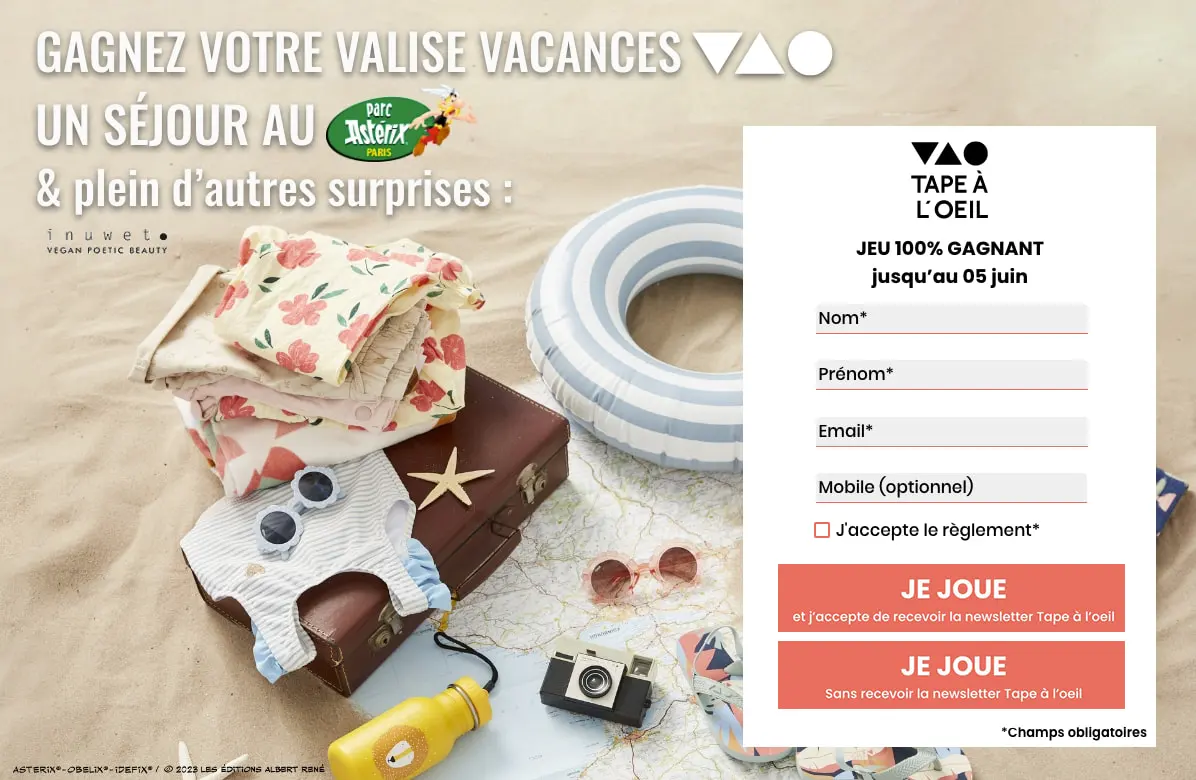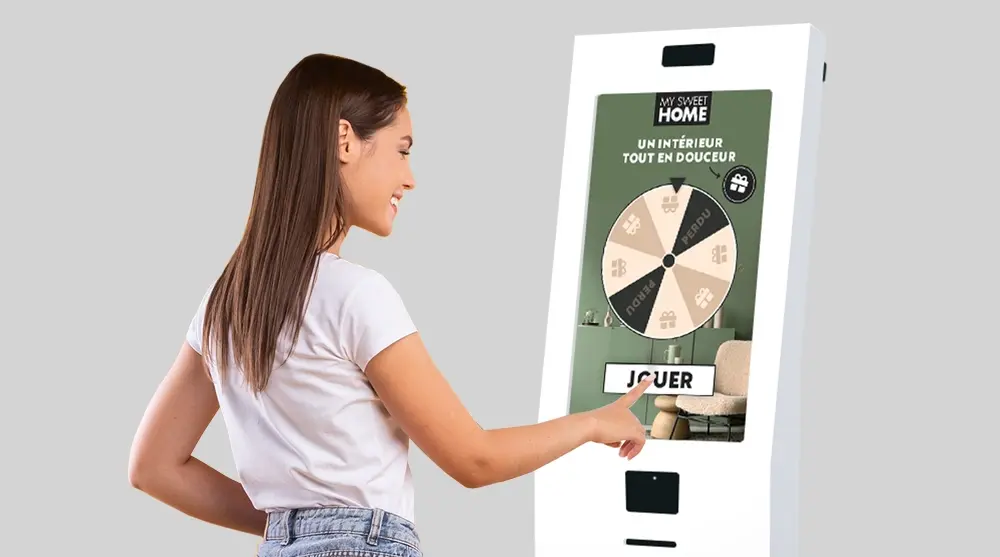
Online sales: how to boost sales through gamification
Online sales are a constantly evolving sector, particularly when it comes to the most effective conversion strategies. Brands are constantly looking for new, more effective and affordable ways of raising brand awareness, boosting sales and building customer loyalty.
One strategy that has always been tried and tested (and proven to be effective at every stage of the conversion funnel) is gamification.. Cette dernière joue en effet sur deux ressorts émotionnels très puissants chez le consommateur : le divertissement et l’opportunité de décrocher une récompense.
To help brands boost sales through gamification.In this article, we present the main advantages of game marketing in e-commerce. You’ll also find a simple, effective strategy for integrating game marketing into your sales funnel.
What is gamification?
Gamification is a marketing concept that involves applying the mechanisms of games (competition, accumulation of points and the hope of a reward) to engage and convert consumers.
Gamification can take the form of a loyalty program offering rewards (such as discount vouchers) in exchange for points accumulated. But also that of an interactive game generating traffic to its online shop.
In short, it’s a multi-faceted approach that aims not only to improve the performance of sales teams, but above all to increase company revenues through innovative interactive strategies.
And it works! A recent study by Gigy shows that gamification boosts consumer engagement by 30%.
One of the pioneers in this field is the Chinese marketplace AliExpress. It offers a gamified model with its ‘Coins and Coupons’ feature. Users can earn coins by completing basic tasks on the platform. They then convert these tokens into discount vouchers for use on the site. The result: a substantial increase in the engagement of AliExpres users, better retention and a record repeat rate.
What online sales challenges can gamification address?
For a brand that wants to increase its online sales, the best strategy will be one that removes the disincentives for potential customers at each stage of the conversion funnel. This is is why gamification is so effective in terms of awareness, consideration, conversion and retention.
Increase brand awareness before launching a new collection
Above all, gamification is an excellent way of increasing visibility and reach a greater number of qualified leads. Thanks to gamification, brands are better able to attract the attention of consumers, offering them a more entertaining and rewarding experience overall.
Many gamified applications incorporate social elements such as ranking, challenges and the ability to share achievements on social networks. This not only encourages users to become brand ambassadors within their own network, while fostering a sense of belonging and community around the company.
By adopting a fun game mechanic such as the piñata (and attractive prizes such as a trip to Parc Astérix), the Tape à l’Oeil brand has increased its visibility and brand awareness. Used as a data collection lever, TAO has succeeded in attracting qualified leads that it can target and retarget, while promoting its spring-summer collection ahead of the holiday period.

Generate more traffic and boost sales during the sales period
When a brand’s customers are regularly involved in marketing games, they are more likely to be loyal and to make new purchases.. Les éléments gamifiés tels que les points de fidélité, les niveaux ou les badges peuvent être liés à des incitations telles que des remises, motivant les utilisateurs à racheter.
According to recent statistics, companies using gamification have seen an increase in their conversion rate of between 15% and 50%.. Pour la marque TAO, l’introduction d’un jeu interactif a engendré une hausse de 27 % des taux de clics vers son site.
Retarget qualified leads with the right product suggestions
The interactive nature of gamification enables companies to collect valuable data on the behaviour and preferences of their target audience. This first-party data can be used to optimise the customer experience, personalise marketing efforts… and ultimately to stimulate business growth.
For example, the brand can trigger a segmented emailing sequence after participation in a marketing game. The participation form or the data collected as part of the game (via a personality test, a swipper or a shopping list) will enable them to better target the buying preferences of their leads. They will then be able to send them tailored content that is more likely to trigger a purchase.
Reduce shopping basket abandonment
One of the biggest problems facing e-tailers is shopping basket abandonment. According to recent research, the average rate of basket abandonment in the e-commerce sector is 75%, which represents a huge loss of revenue.
Gamification helps to overcome this by creating a sense of urgency, which encourages customers to complete their order. This could be a discount coupon with a time limit.
3 steps to boost your conversion strategy with gamification
The results offered by gamification for online retailers will depend on their ability to choose the right game mechanics depending on their objective. Here’s our advice on how to optimise your gamified customer experience.
Step 1: Define your objectives (conversion, lead generation)
The first step in a gamification-fuelled conversion strategy is to identify the behaviour the brand wants to encourage. Do they want users to buy more products, share content about the brand, leave a review after receiving their order?
By defining these objectives, the company can build a relevant gamification system. For example, Amazon encourages its users to rate its products by offering them the opportunity to become a ‘best reviewer’. This leads to a 58% increase in the number of reviews left and boosts the reassurance of new prospects arriving on a product sheet.
Step 2: Choose the right game mechanics
Depending on the objectives defined, the brand can then choose the right gamification mechanics. Games that are fun and clearly present the possibility of winning a reward are very effective for generating leads and increasing visits to an online shop.
Brands will be able to opt for the winning instant with an e-mail address capture form. Thanks to a tracking pixel set up on the game, it is easy to track sales made by participants in the instant win, and thus calculate the ROI of the marketing campaign.
The same applies to a mechanical device such as the Gatecode which implies an obligation to buy. This type of interactive game is perfect for boosting online sales, as you need to be able to show proof of purchase in order to play. This effectively increases the chances of conversion and loyalty.
The choice of rewards is also crucial. To make sure you get it right, read our guide to offering the right gifts.

Step 3: Test, iterate and improve to maximise conversions
As with any online sales strategy, it is essential to test your gamification elements to evaluate their effectiveness, brands will be able to integrate a form into their interactive games to gather feedback from users. This will enable them to identify areas for improvement to enhance their experience.
Conclusion
In an increasingly competitive e-commerce landscape, gamification is an excellent vector for differentiation. It will enable brands to facilitate the progression of their leads through their conversion funnel and boost their growth. Find out how to get started with an effective gamification strategy, discover all the Adictiz game mechanics!








